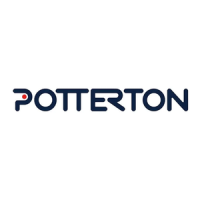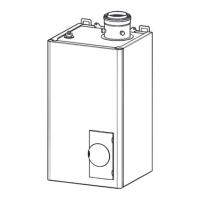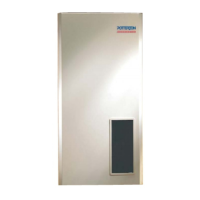Do you have a question about the Potterton Paramount three 115 and is the answer not in the manual?
Provides critical safety instructions regarding life danger, electric shock, and improper use.
Presents detailed technical specifications including gas category, heat input/output, and emission factors.
Continues the technical specifications table, covering heating water, hydraulic resistance, and electrical power.
Outlines the quality requirements for heating circuit water to prevent corrosion and scaling.
Covers water treatment, system volume determination, and additive usage.
Details the use of antifreeze in heating systems with aluminium heat exchangers and mixing ratios.
Covers notes for installation location, including room requirements and wall clearances.
Provides guidelines for the flue gas connection, emphasizing temperature limits and specialist consultation.
Presents tables detailing flue types, sizes, lengths, and bends for various Paramount models.
Details the assembly of the exhaust gas system, including downward slope and pipe shortening.
Details the gas connection requirements, including specialist installation and recommended filters.
Stresses the importance of checking the gas inlet pipe for leakages.
Specifies the required supply pressure ranges for natural gas and liquid gas.
Emphasizes that electrical work must be done by a qualified electrician and specifies mains supply requirements.
Provides instructions for switching on the boiler, including safety warnings about scalding.
Covers customer instruction regarding operation, safety, and self-checks.
Provides a checklist for commissioning, covering system checks, gas values, and documentation.
Outlines the procedure for accessing and selecting programming levels and menu points.
Explains how to modify parameters not directly accessible via the front panel, using the setting level.
Presents a table of settable parameters, their program numbers, levels, and standard values.
Covers settings for language, display contrast, operation lock, and unit selection.
Explains time programs for heating circuits, DHW, and circulation pumps, including preselection, phases, and copying.
Details settings for heating circuits: comfort setpoint, reduced setpoint, frost protection, and heating curve.
Covers domestic hot water settings, including nominal/reduced setpoints and release options.
Covers settings for consumer circuits and swimming pool, including flow setpoints and DHW charging priority.
Details settings for swimming pool heating, including solar and generator heating setpoints and priorities.
Covers settings for primary controller/system pump, including flow setpoint limits and heat generation lock.
Details boiler operation settings, including release below outside temp, full charging buffer, and setpoints.
Details cascade operation settings, including lead strategy and boiler switching.
Covers solar system settings, including temperature differences for collector pump control.
Details buffer storage settings, including automatic heat generation lock and temperature differences.
Covers DHW storage settings, including full charging, minimum temperatures, and push forward times.
Covers configuration settings for heating circuits, DHW sensors, and control elements.
Covers LPB system settings, including device address, bus power supply, and system messages.
Covers fault messages, SW diagnostic codes, fault phases, and alarm relay resets.
Covers settings for burner maintenance intervals, fan speed, and chimney-sweep function.
Explains how to display nominal/actual values, relay statuses, and counter statuses for diagnosis.
Covers burner control parameters like prepurge time, nominal output, and fan speed.
Provides a table of fault codes, descriptions, and explanations/causes, often requiring heating specialist input.
Continues the fault code table, listing faults related to module functions, sensors, and system components.
Provides critical safety instructions regarding life danger, electric shock, and improper use.
Presents detailed technical specifications including gas category, heat input/output, and emission factors.
Continues the technical specifications table, covering heating water, hydraulic resistance, and electrical power.
Outlines the quality requirements for heating circuit water to prevent corrosion and scaling.
Covers water treatment, system volume determination, and additive usage.
Details the use of antifreeze in heating systems with aluminium heat exchangers and mixing ratios.
Covers notes for installation location, including room requirements and wall clearances.
Provides guidelines for the flue gas connection, emphasizing temperature limits and specialist consultation.
Presents tables detailing flue types, sizes, lengths, and bends for various Paramount models.
Details the assembly of the exhaust gas system, including downward slope and pipe shortening.
Details the gas connection requirements, including specialist installation and recommended filters.
Stresses the importance of checking the gas inlet pipe for leakages.
Specifies the required supply pressure ranges for natural gas and liquid gas.
Emphasizes that electrical work must be done by a qualified electrician and specifies mains supply requirements.
Provides instructions for switching on the boiler, including safety warnings about scalding.
Covers customer instruction regarding operation, safety, and self-checks.
Provides a checklist for commissioning, covering system checks, gas values, and documentation.
Outlines the procedure for accessing and selecting programming levels and menu points.
Explains how to modify parameters not directly accessible via the front panel, using the setting level.
Presents a table of settable parameters, their program numbers, levels, and standard values.
Covers settings for language, display contrast, operation lock, and unit selection.
Explains time programs for heating circuits, DHW, and circulation pumps, including preselection, phases, and copying.
Details settings for heating circuits: comfort setpoint, reduced setpoint, frost protection, and heating curve.
Covers domestic hot water settings, including nominal/reduced setpoints and release options.
Covers settings for consumer circuits and swimming pool, including flow setpoints and DHW charging priority.
Details settings for swimming pool heating, including solar and generator heating setpoints and priorities.
Covers settings for primary controller/system pump, including flow setpoint limits and heat generation lock.
Details boiler operation settings, including release below outside temp, full charging buffer, and setpoints.
Details cascade operation settings, including lead strategy and boiler switching.
Covers solar system settings, including temperature differences for collector pump control.
Details buffer storage settings, including automatic heat generation lock and temperature differences.
Covers DHW storage settings, including full charging, minimum temperatures, and push forward times.
Covers configuration settings for heating circuits, DHW sensors, and control elements.
Covers LPB system settings, including device address, bus power supply, and system messages.
Covers fault messages, SW diagnostic codes, fault phases, and alarm relay resets.
Covers settings for burner maintenance intervals, fan speed, and chimney-sweep function.
Explains how to display nominal/actual values, relay statuses, and counter statuses for diagnosis.
Covers burner control parameters like prepurge time, nominal output, and fan speed.
Provides a table of fault codes, descriptions, and explanations/causes, often requiring heating specialist input.
Continues the fault code table, listing faults related to module functions, sensors, and system components.











